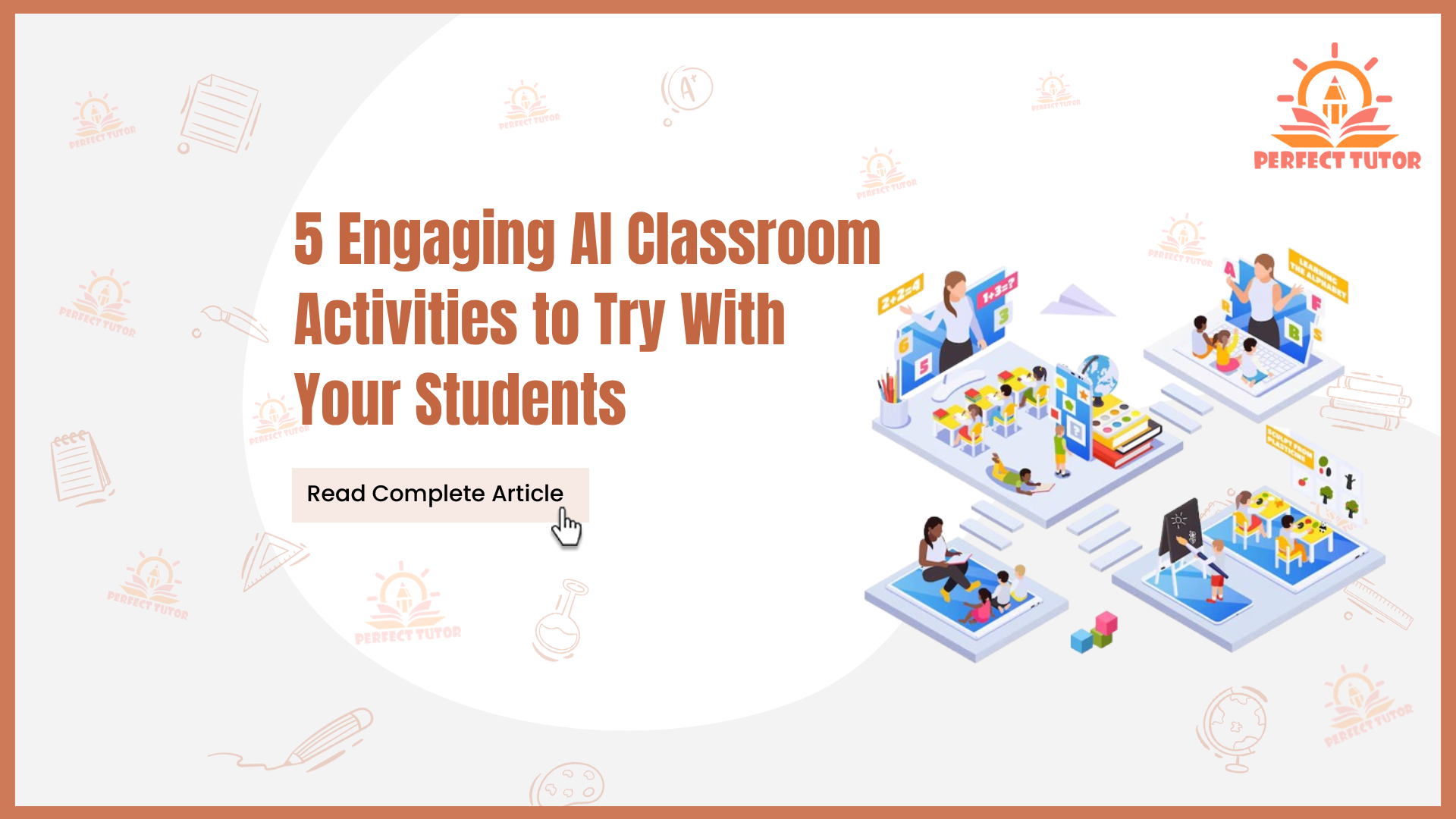5 Engaging AI Classroom Activities to Try With Your Students
Artificial Intelligence (AI) is no longer something we only see in movies. It is now part of our everyday life, and it is quickly becoming a helpful tool in classrooms too. AI can make lessons more enjoyable, creative, and meaningful for students. Teachers can use it to create new learning experiences that spark interest, boost imagination, and help students learn important digital skills.
In this blog, we will explore five engaging AI-based classroom activities that you can try with your students. These activities are practical, enjoyable, and easy to introduce,even if you’re new to AI.
Why Use AI in the Classroom?
Before jumping into the activities, it’s important to understand why AI can be a great addition to your teaching toolkit.
Here are a few good reasons:
It personalizes learning: AI can adjust tasks to match each student’s learning level and style.
It keeps students engaged: Many AI tools are interactive and enjoyable, which helps hold students' attention.
It encourages creativity: AI can support creative writing, visual design, and project work.
It teaches digital skills: Using AI helps students understand how modern technology works.
It gives instant feedback: AI tools can quickly check answers and guide students on how to improve.
Let’s now look at five classroom activities you can try using AI tools.
1. Creative Writing with AI Tools
Activity Name: AI Story Builder
Best For: Grades 3 and up
Main Skills Learned: Writing, imagination, teamwork, digital thinking
How It Works
In this activity, students create stories with help from an AI tool like ChatGPT or Canva. Start by giving them a simple story prompt. For example, “Two children discover a secret door at school.” Students then use AI to help them build characters, write dialogues, or develop different story endings.
Steps to Try This Activity:
Begin with a enjoyable writing prompt.
Let students work in pairs or small groups to plan their story.
Use an AI tool to help add more ideas, suggest dialogue, or check grammar.
Students write their full story, adding visuals using AI image tools if possible.
Share the stories with the class and reflect on how AI helped.
Why It’s Effective
Students feel more confident and excited about writing when they get a little support. This activity also shows how AI can be a helpful partner in creative work, not just a machine that gives answers.
2. Create Quizzes and Games with AI
Activity Name: AI Quiz Master
Best For: Grades 4 and up
Main Skills Learned: Subject review, question design, collaboration, assessment
How It Works
Instead of only answering quizzes, students get to help create them! Using tools like ChatGPT or Curipod, you can make enjoyable quizzes or games based on topics your class has studied, like science, history, or grammar.
Steps to Try This Activity:
Pick a subject or chapter your class recently studied.
Ask students what types of questions they would like to include.
Use an AI tool to generate quiz questions or game ideas.
Play the quiz as a class using digital tools or printed formats.
Review the results and let students suggest new ideas for next time.
Why It’s Effective
This activity turns revision into a game. It also gives students a chance to think like teachers and understand what makes a good question. They also learn how AI can help with research and educational design.
3. Explore Face Sensing and Emotion Detection
Activity Name: AI Face Finder
Best For: Grades 5 and up
Main Skills Learned: Coding basics, technology awareness, emotions, and expression
How It Works
AI can recognize facial expressions and emotions. Using platforms like Google’s Teachable Machine or Scratch Lab, students can create simple games or tools that react to smiling, frowning, or other facial movements.
Steps to Try This Activity:
Introduce how AI can read faces and detect emotions.
Let students experiment with Scratch Lab to create games that respond to facial expressions.
Use Teachable Machine to train a basic AI model to recognize “happy,” “sad,” or “surprised” faces.
Students test their projects and present what they created.
Why It’s Effective
Students gain hands-on experience with how AI sees and responds to images. It also opens up conversations about how technology can understand human behavior and how it should be used responsibly.
4. Create Art Using AI Image Generators
Activity Name: AI Art Studio
Best For: Grades 2 and up
Main Skills Learned: Visual creativity, storytelling, design thinking
How It Works
Students describe a scene or character, and AI turns it into a picture. This is a enjoyable way to explore creativity. Tools like Canva, Picsart, or AI art features in ChatGPT can be used to generate images based on short text inputs.
Steps to Try This Activity:
Ask students to imagine something creative (e.g., “a penguin playing guitar on the moon”).
Let them describe it in a sentence or two.
Use an AI image tool to generate the visual.
Ask them to write a small story or caption for their image.
Display the artwork in class or create a digital wall gallery.
Why It’s Effective
This activity brings imagination to life. It allows students to see how their ideas can turn into real images, and they enjoy being the creators. It also teaches them about how AI understands and responds to words.
5. Run an AI-Powered Scavenger Hunt
Activity Name: AI Clue Quest
Best For: Grades 3 and up
Main Skills Learned: Problem-solving, teamwork, reading clues, and physical activity
How It Works
Use AI to create enjoyable riddles, clues, or tasks for a scavenger hunt. Students work in teams to find items or solve puzzles around the classroom or school.
Steps to Try This Activity:
Choose a theme like “science lab” or “classroom objects.”
Use AI to help you create a list of creative clues or emoji hints.
Divide the class into small groups and give them the clues.
Let them search for the items or solve the challenges.
Celebrate the winners and reflect on how the clues were created.
Why It’s Effective
It gets students moving and thinking. They also see how AI can be used to create enjoyable activities, not just academic tasks. It’s a great mix of physical learning and digital support.
Tips to Make AI Activities Work Better
Here are some helpful tips when trying AI classroom activities:
Start small: Don’t try everything at once. Begin with one simple activity and build from there.
Work in groups: Students enjoy learning when they work together and share ideas.
Review together: After the activity, ask students what they learned and how the AI helped.
Stay safe: Use tools made for kids and supervise online work. Avoid anything that requires sharing personal data.
Let it be enjoyable: These activities are meant to bring energy and joy into learning. Allow space for laughter and creativity.
Looking Ahead: AI and the Future of Learning
AI is changing the way we teach and learn. It is already a part of many areas in life, from mobile apps to search engines, and will be even more common in the future. By using AI in the classroom now, we are helping students become confident with technology and creative problem-solvers.
These activities are more than just enjoyable, they prepare students for a future where AI will be part of everyday life. And the best part? Students are not just using technology, they’re learning how it works and how they can create with it.
Final Thoughts
Bringing AI into your classroom doesn’t need to be complicated. These five activities, creative storytelling, quiz building, emotion detection, AI art creation, and scavenger hunts, are great ways to begin. They offer enjoyable, hands-on experiences while helping students build useful skills for the future.
Let your students explore, create, and learn with a little help from AI.



 +91 8700847275
+91 8700847275
 +1 8009616567
+1 8009616567